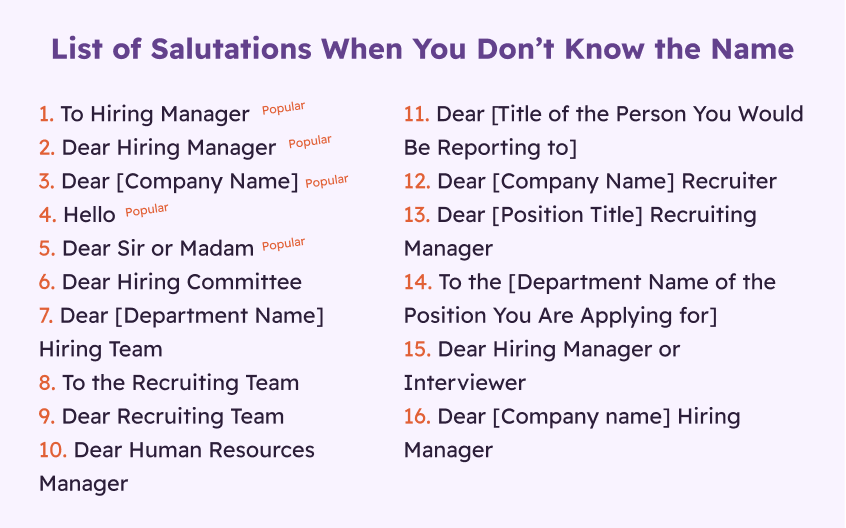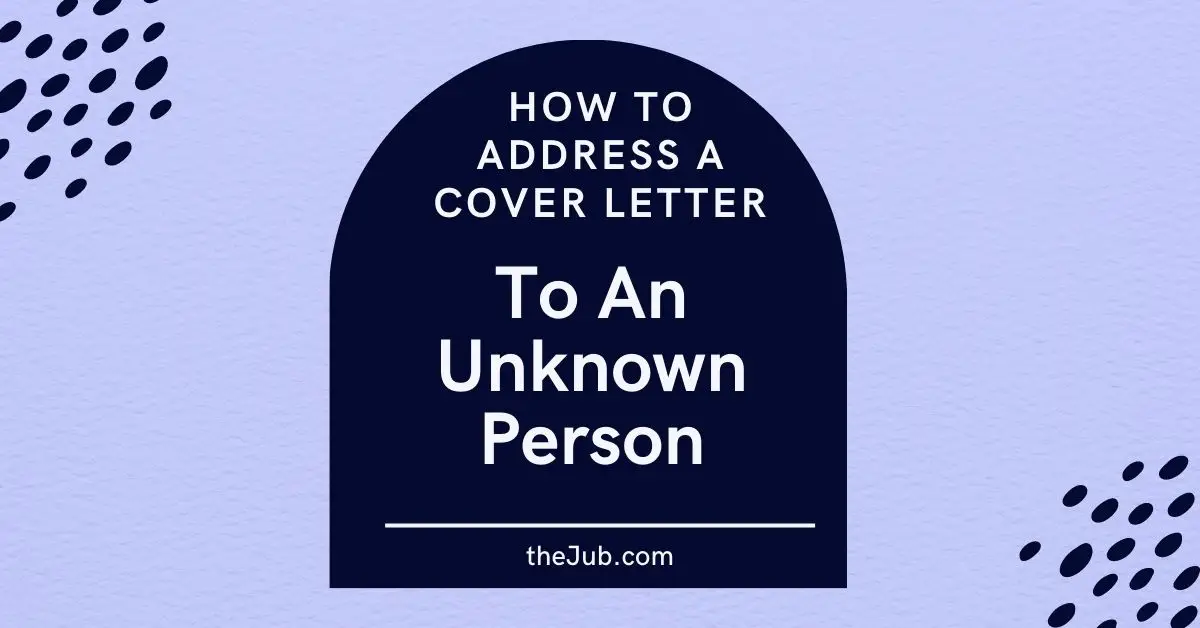20 Examples Of How To Address a Cover Letter to an Unknown Recipient
Introduction.
Imagine sending out dozens of job applications, only to realize that you've been addressing your cover letters incorrectly. As it turns out, addressing a cover letter to an unknown recipient can be a tricky task. In this comprehensive guide, we'll provide strategies for finding the right name, using job titles as an alternative, formatting the letter, avoiding common mistakes, leveraging professional networking, and understanding the importance of personalization. By following our advice, you can increase your chances of landing that job interview and making a great first impression.

Finding the Right Name
Before you give up on finding the recipient's name, consider these research strategies:
Check the job post for a specific name. Sometimes, the name of the hiring manager or contact person is listed in the job posting. Read the post carefully to see if a name is mentioned.
Search the company website for a company directory or listing of key personnel. Many organizations have a "Meet Our Team" or "About Us" section that introduces their staff members. Look for someone with a relevant title, such as "Hiring Manager" or "Human Resources Director."
Call the company directly and ask for the appropriate contact person. If you're unable to find the name online, consider calling the company and asking for the name of the person responsible for hiring for the position you're applying for. This approach can be particularly effective for smaller organizations.
Utilize professional networking platforms like LinkedIn to find the recipient. LinkedIn is a powerful tool for job seekers. Try searching for employees at the company with relevant titles, then check their profiles for clues about their role in the hiring process. You can learn more about how to find the name of the hiring manager using LinkedIn in this helpful article.
Personalize your cover letter. Addressing your cover letter to a specific individual shows that you've done your homework and are genuinely interested in the position. This extra effort can make a big difference in how your application is perceived by the recipient.
Using a Job Title
If you're unable to find the recipient's name, consider using a job title or department head as an alternative:
Address the letter to the job title of the reader. For example, you might write "Dear Hiring Manager" or "Dear Human Resources Director." This approach is more specific and professional than using a generic greeting like "To Whom It May Concern."
Consider addressing the letter to the head of the department where you're applying to work. If you know the department your job falls under, try addressing your cover letter to the department head, such as "Dear Marketing Director" or "Dear IT Manager."
Explain why using a job title or department head can still demonstrate professionalism and personalization. Although it's not as ideal as using a specific name, addressing your letter to a relevant job title shows that you've put some thought into your application and have a clear understanding of the company's structure.
Provide examples of different job titles to use as salutations. You can find a list of different job titles to use as salutations in this resource.
Discuss the potential impact of using job titles on the success of the job application. While using a job title may not guarantee success, it can increase your chances of making a favorable impression. A personalized salutation indicates that you're genuinely interested in the position and have taken the time to research the company.
Formatting the Letter
When addressing a cover letter to an unknown recipient, follow these formatting tips:
Always use "Dear" to start the address. This is a professional and respectful way to begin a cover letter.
Use a gender-neutral title (such as Ms.) if the recipient's gender is unknown. If you're unsure of the recipient's gender, it's better to use a neutral title like "Ms." rather than making assumptions.
For non-gender-specific names, use the recipient's full name. If you can't determine the recipient's gender based on their name, address the letter using their full name, such as "Dear Taylor Smith."
Maintain a professional tone even when the name is unknown. Even if you don't know the recipient's name, it's crucial to keep your language and tone professional throughout your cover letter.
Provide examples of well-formatted cover letter salutations.
While it's always best to try and find the name of the hiring manager or recruiter, there may be times when you just can't find that information. Don't let it deter you. Below are 20 examples of how you can address your cover letter when the recipient is unknown:
1. Dear Hiring Manager, 2. To the Recruitment Team, 3. Dear Human Resources Team, 4. Attention Hiring Committee, 5. Dear [Job Title] Hiring Team, 6. To the [Company Name] Team, 7. Dear [Company Name] Recruiter, 8. To Whom It May Concern, 9. Dear Hiring Authority, 10. Attention [Company Name] Hiring Professionals, 11. Dear Talent Acquisition Team, 12. Hello [Company Name] Selection Panel, 13. Dear Recruitment Advisor, 14. To the [Industry] Professionals at [Company Name], 15. Attention [Company Name] Talent Scouts, 16. Dear Hiring Advocate, 17. To the Selection Committee for [Job Title], 18. Dear [Company Name] Staffing Team, 19. Attention [Job Title] Recruitment Panel, 20. Dear [Company Name] Hiring Panel,
Remember, the goal is to be as respectful and professional as possible in your salutation. Even if you don't know the recipient's name, demonstrating courtesy in your greeting will set a positive tone for the rest of your cover letter.
Also, avoid overly casual greetings like 'Hello' or 'Hi there,' which might seem unprofessional, and stay clear of outdated phrases such as 'Dear Sir or Madam.' Instead, opt for more modern, inclusive alternatives. Be sure to follow your greeting with a comma or a colon, then leave a space before starting the body of your letter.
Avoiding Common Mistakes
When addressing a cover letter to an unknown recipient, it's essential to avoid these common mistakes:
Using generic greetings like "To Whom It May Concern." This phrase is outdated and impersonal, and using it can make your application seem generic and unprofessional. Instead, try to find a specific name or use a job title, as discussed in previous sections.
Using incorrect titles or making assumptions about the recipient's gender. Making assumptions about someone's gender or using an inappropriate title can potentially offend the recipient and hurt your chances of landing an interview. Stick to gender-neutral titles or use the recipient's full name when in doubt.
Addressing the letter to the wrong department or job title. Be sure to double-check that you're addressing your letter to the appropriate person or department. Sending your application to the wrong person can result in your application being overlooked or discarded.
Failing to proofread the cover letter for errors, even in the salutation. Typos and other errors can make a poor impression on the recipient. Be sure to proofread your entire cover letter, including the salutation, before submitting it.
Provide examples of mistakes that could hurt the applicant's chances of landing an interview. Some examples of common errors include misspelling the recipient's name, using an informal greeting (such as "Hey"), or addressing the letter to an unrelated department (e.g., "Dear Accounting Manager" when applying for a marketing position).
Utilizing Professional Networking
Leveraging your professional network can be an effective way to find the name of the recipient for your cover letter:
Use platforms like LinkedIn to research the company and its employees. As mentioned earlier, LinkedIn is a valuable resource for job seekers. You can use the platform to find employees with relevant titles, learn more about the company culture, and even discover mutual connections who might be able to provide an introduction or additional information.
Connect with current employees or alumni of the company. Networking with people who work at the company or have worked there in the past can give you valuable insights into the hiring process and help you identify the appropriate contact person for your cover letter.
Search for the appropriate contact person within your professional network. Use your connections to find people who work at the company you're applying to, and ask if they know who the hiring manager for your desired position is.
Networking can help job seekers get noticed by potential employers. Building relationships with people at the company can increase your chances of getting noticed and potentially even lead to a referral. Learn more about how networking can help job seekers get noticed by potential employers in this article.
Offer examples of successful job seekers who found the recipient's name through networking. For instance, this cover letter that landed a job seeker a role at LinkedIn is a great example of how personalizing your cover letter and leveraging your network can help you stand out.
Importance of Personalization
Personalizing your cover letter can make a significant difference in the success of your job application:
Discuss the impact of personalization on the reader's impression of the applicant. A personalized cover letter demonstrates that you've done your research and are genuinely interested in the position, which can make a positive impression on the recipient.
Provide statistics on the success rate of personalized cover letters compared to generic ones. According to resume statistics , candidates with typos in their cover letters or resumes are 58% more likely to be dismissed, while those who do not include specific employment dates are 27% more likely to be dismissed.
Offer expert opinions on the importance of addressing cover letters to specific individuals. Many career experts agree that addressing cover letters to specific individuals can increase your chances of landing an interview.
Explain how personalization demonstrates research skills and genuine interest in the company. Taking the time to research the recipient and tailor your cover letter to the specific position and company shows that you're not only a thorough and detail-oriented candidate, but also genuinely interested in the opportunity.
Share anecdotes of successful job seekers who personalized their cover letters and landed interviews. For example, one job seeker found the recipient's name through LinkedIn and personalized his cover letter , which helped him land an interview and ultimately secure the position.
Conclusion and Final Thoughts
In summary, addressing a cover letter to an unknown recipient can be challenging, but by following our tips and strategies, you can make a strong impression on potential employers. Remember to:
- Research the recipient's name or use a relevant job title.
- Personalize your cover letter to demonstrate genuine interest in the position.
- Maintain a professional tone and formatting throughout your cover letter.
- Avoid common mistakes that can hurt your chances of landing an interview.
- Leverage your professional network to find the appropriate contact person.
By applying these tips to your job search, you'll increase your chances of success and make a lasting impression on potential employers. Good luck with your job applications!
Explore Jobs
- Jobs Near Me
- Remote Jobs
- Full Time Jobs
- Part Time Jobs
- Entry Level Jobs
- Work From Home Jobs
Find Specific Jobs
- $15 Per Hour Jobs
- $20 Per Hour Jobs
- Hiring Immediately Jobs
- High School Jobs
- H1b Visa Jobs
Explore Careers
- Business And Financial
- Architecture And Engineering
- Computer And Mathematical
Explore Professions
- What They Do
- Certifications
- Demographics
Best Companies
- Health Care
- Fortune 500
Explore Companies
- CEO And Executies
- Resume Builder
- Career Advice
- Explore Majors
- Questions And Answers
- Interview Questions
10 Best Ways To Address A Cover Letter Without A Name
- Cover Letter Format
- Salutation and Greeting
- Who To Address When Unknown
- How To Start A Cover Letter
- How To End A Cover Letter
- Best Cover Letter Font And Size
- Cover Letter Spacing
- Cover Letter Length
- Key Elements Of A Cover Letter
- How To Write An Address
- Official Letter Format
- Cover Letter Opening
Find a Job You Really Want In
Cover letters consume a fair amount of time in the application process, as the more personalized they are, the better. With the majority of the application process being automated and online now, the hiring manager ’s name can end up being an unknown quantity. If you don’t know the hiring manager’s name and don’t know what to do, then this article will help you.
If the hiring manager’s name is unknown, then you have a few options. The best, of course, is to find out what their name is and address the letter to them. But if that all fails, then there are proper ways to address a cover letter to an unknown recipient.
Key Takeaways:
Try to find the name of the person you are addressing using the job listing, company website, or contacting the company.
Don’t assume someone’s martial status and avoid using “Miss” and “Mrs.” whenever possible.
Avoid assuming gender, even if you do know the person’s name.
Use a professional and appropriate greeting and avoid sounding like you would when addressing your friend.

How to address a cover letter if you don’t know the recipient’s name
Why is addressing a cover letter correctly important, how to find out who to address your cover letter to, example cover letter, addressing a cover letter faq, final thoughts, expert opinion.
- Sign Up For More Advice and Jobs
There are a few rules to follow when addressing a cover letter: be professional, polite, and concise. That means that even if you don’t know the recipient’s name, you want to maintain the same professional tone in the letter and avoid overly stilted language or being too informal.
Here are some guidelines to follow when addressing a cover letter:
If you can find out the hiring manager’s name, do so. That means that you should spend time looking over the company website, checking LinkedIn profiles, or even calling the company.
Don’t assume the hiring manager’s gender. This is especially true when you don’t know their name. But even if you do find out the person’s name, avoid gendered language until you’re sure how they identify. Some people will put preferred pronouns in email signatures or on their LinkedIn profiles, so it might be a good idea to check.
Maintain a professional tone. There’s a common style and formality to business letters. Make sure that your cover letter has that tone. it’s different than a letter you’d write to a friend, and being too familiar with your writing can be off-putting to hiring managers.
Avoid assuming the person’s title. This applies to both marital status, such as using Mrs. or Miss, but also whether they have a doctorate. In general, unless this is someone you know, avoid using either Mrs. or Miss, because it can cause offense, even if used correctly.
Make sure you include a salutation. Even if you don’t know who you’re addressing, leaving one off entirely can end up either looking like a mistake or that you didn’t personalize the letter at all.
Be as specific as possible. Even if you can’t find out exactly who the hiring manager is, make sure to be specific in your greeting. Use Dear Marketing Hiring Manager rather than just Dear Hiring Manager if you’re applying for a marketing position.
Also, while HR is most often in charge of hiring, it’s best not to just address the HR department unless you know that they’re the ones who’ll be in charge of your application. Not every business has HR take care of all hiring tasks, especially if it’s a smaller company.
Examples of how to address a cover letter:
Dear Sir or Madam
Dear Hiring Manager
Dear Talent Acquisition Team
Dear [Company Name] HR Department
Dear [Company name] Hiring Manager
Dear Human Resources Manager
Dear Human Resources Department
Dear [Company Name] Recruiter
Dear [Department Name] Hiring Manager
Dear [Department Name] Hiring Team
Here are some examples of how NOT to address a cover letter:
Good Morning
To Whom It May Concern
Dear Mrs. Smith
Hi Sebastian!
Hey Sales Team
Addressing a cover letter correctly shows professionalism, diligence, and politeness. All of these are good for an employee to have and show you to be someone that’s worth investing further time in. While finding the proper person to address can be a chore, it helps you in several ways because:
Hiring managers get myriad applications. Remember that you aren’t the only one applying for a job. While you want to make your application stand out from the crowd if you can, you don’t want to stand out in a negative way — that’ll ensure you don’t get the job.
Individual people ultimately decide who gets hired. While the application process can feel faceless, formless, and impersonal, there are actual people at these companies that sort through resumes . And people form first impressions.
It shows that you’re willing to go the extra mile. Think about what the admired traits are in employees. If you’re willing to put in the additional effort or work to get a superior result, then that’s the sort of employee companies want to have to work for them.
It’s less impersonal. Of course the hiring process is somewhat impersonal. You’re petitioning people you don’t know and that don’t know you. But if you address a letter to Dear Hiring Manager, it doesn’t have the same effect as addressing it directly to the person.
Despite the importance of properly addressing a cover letter, not every company makes it easy for applicants to do. If the hiring manager’s name isn’t immediately apparent, then there are some other options open to you before addressing the cover letter to an unknown recipient.
Check the job listing. One simple way is to look at the application and double-check that the hiring manager’s name isn’t on the main listing. Sometimes the information isn’t on the application, but rather on the job listing. If it isn’t there you will then have to start doing a little bit more investigative work.
Check LinkedIn. You can check on LinkedIn and on the company’s website to find the hiring manager’s name. If nothing shows up, then you will have to start contacting someone at the company to find out.
Contact the company. Now, this does not mean you should contact some random person at the company who lists the company’s name on their profile. Find the contact information for the HR department, for someone who works in HR, or for the head of the department you are trying to work in and ask them if they know the name of the hiring manager for your application.
Sometimes, they will not give this information, simply so that the hiring manager can stay anonymous and not get a billion emails from applicants. This situation is more likely to happen with massive companies like Google or Apple.
If they give you a name, use it. If they don’t, then you will have to then move on to the next step of figuring out how to address a cover letter to an unknown person.

Dear Sales Team Hiring Manager, As a fan of XYZ Inc.’s impressive technology products, I was ecstatic to see an opening for a Junior Sales Representative . After reading the job description, I am confident that I’m the right person for the job. With 4 years of experience selling cloud computing products and services, I would bring a unique perspective to the role. In my current role as a Sales Representative at ABC Corp., I’ve created technology presentations for all my clients, driving interest in new product sales and subscriptions by 84% year-over-year. Additionally, I’ve reduced the cost of customer acquisition by over 15% and consistently topped sales quotas by over 20% since starting at ABC. I know XYZ has amazing products and services that I would be honored to promote and sell. With my background in cloud computing, I would be able to hit the ground running and communicate your product’s benefits to customers. Please contact me if you have any further questions about my application or resume. I look forward to speaking with the Sales Team more about the role in an interview. Thank you for your time and consideration. Sincerely, Malia Freeman [email protected] 555-777-9999
How do you address a cover letter to an unknown recipient?
Address your cover letter to “Hiring Manager” or “[Department Name] Hiring Manager.” Always do whatever you can to try to find the name of the person you’re addressing, but if you can’t, address it to the generic position or team you’re trying to get in contact with.
Is To Whom It May Concern rude?
Yes, To Whom It May Concern can be considered rude. Not everyone will agree that it’s rude, but many people do find it rude, or at least impersonal and lazy on a cover letter, so it’s best to avoid this greeting
Is it okay to use Dear Hiring Manager?
Yes, it is okay to use Dear Hiring Manager as a cover letter greeting. It’s always best to address your cover letter to someone by name if you can find it, but many times you can’t. In this case, “Dear Hiring Manager,” is an appropriate greeting.
Who is the best person to address a cover letter to?
The best person to address a cover letter to would be the hiring manager. This should be their first and last name if you know it, but “dear hiring manager” is acceptable if you are unsure of their name.
The rule of thumb was to use titles such as Mr. or Ms. However, it’s also important not to assume the hiring manager’s gender. If you don’t know the person’s preferred pronouns, then it’s best to just use their full name.
If you don’t know the recipient’s name, how would you close the letter?
Sincerely or Regards are considered formal, professional closings for letters. If you’re writing a cover letter to someone you don’t know, it’s best to remain professional and polite. A sign-off such as best wishes will likely come off as too familiar.
If you are applying for a job and writing a cover letter, make sure you take the time to look over all the details in the cover letter. Not taking the time to look for the recipient of a cover letter or using a professional greeting will look lazy. Your greeting is a small part of the cover letter. However, it’s one of the most important pieces because it’s the first thing the hiring managers will read. Using an appropriate generic greeting will set the tone for your cover letter, making you sound professional and willing to put in the effort to make your cover letter flawless. Now that you know how to address a cover letter if the reader is the recipient is unknown, check out our other articles about cover letters and the job application process.
Applying for jobs can be stressful and tedious, but taking the time to learn tips on how to improve your application will help put you one step closer to landing your dream job .
Georgetown – Writing Cover Letters for Government
- Who To Address Cover Letter To If Unknown

Vimari Roman Career Strategist Coach Be Productive Coaching
My recommendation is to always send a customized cover letter when applying for any job and when in doubt, address your letter to the hiring team using “Dear Hiring Team.” In most cases the application will end up on a recruiter’s or an HR Business Partner’s desk, and if they like your cover letter and resume, then they will pass it on to the hiring manager or the hiring team. By addressing your letter to the “team” you’ve got everyone covered and they will all feel as if the letter was written directly to them.
Expert Tip To Find Contact Infoformation

Sally Mikhail Founder of Recruit Petra LLC
Use LinkedIn to find out who to address your cover letter to you with a search of company personnel on the company careers page . However, if you are sending out a cover letter to an unknown hiring influence, you can address it to “Dear Hiring Team” or “Dear Hiring Manager.”
Who To Address Cover Letter To If Unknown Tip

Chelsea Jay Certified Resume Writer and Career Coach
Make sure that you review the company’s “About Me” or “Staff” to view their leaders which often lists direct managers, HR professionals, and executive leadership staff. If you know what department you’ll be working for, I recommend addressing the leader of that department. If the website is for a larger organization and does not list individual staff, I recommend utilizing LinkedIn. You can do a quick company search and find employees who are currently working there. You may even find the original posting with the hiring manager’s name attached.
If you cannot find the hiring manager’s name based on the posting, I recommend taking time to learn more about the specific department you’ll be working in. For example, if you discover that you’ll be working in the Communications department, the next step would be to learn about the specific team you’ll be part of. If you find out that it is the Public Affairs team, I encourage you to address “Public Affairs Team” at the beginning of your cover letter.
If you’re up for a bolder approach that is sure to get attention, address someone on the executive leadership team. I recommend addressing the President or Vice President of the organization (they should be easy to find since they are often the “face” of the organization). Of course, address them with a salutation along with their first name, last name, and title. In the beginning of the cover letter make sure to distinguish what department and position you are applying for. For example, Dear Mr. John Smith, President.
As an applicant, your goal is to stand out and showcase that you are informed and willing to go the extra mile (by doing research!).
Your browser does not support the video tag.
How useful was this post?
Click on a star to rate it!
Average rating / 5. Vote count:
No votes so far! Be the first to rate this post.

Heidi Cope is a former writer for the Zippia Career Advice blog. Her writing focused primarily on Zippia's suite of rankings and general career advice. After leaving Zippia, Heidi joined The Mighty as a writer and editor, among other positions. She received her BS from UNC Charlotte in German Studies.
Matt Warzel a President of a resume writing firm (MJW Careers, LLC) with 15+ years of recruitment, outplacement, career coaching and resume writing experience. Matt is also a Certified Professional Resume Writer (CPRW) and Certified Internet Recruiter (CIR) with a Bachelor of Science in Business Administration (Marketing Focus) from John Carroll University.
Recent Job Searches
- Registered Nurse Jobs Resume Location
- Truck Driver Jobs Resume Location
- Call Center Representative Jobs Resume Location
- Customer Service Representative Jobs Resume
- Delivery Driver Jobs Resume Location
- Warehouse Worker Jobs Resume Location
- Account Executive Jobs Resume Location
- Sales Associate Jobs Resume Location
- Licensed Practical Nurse Jobs Resume Location
- Company Driver Jobs Resume
Related posts

6 Tips On How To Address Your Cover Letter

How To Write A Letter Of Intent For A Job (With Examples)

Cover Letter Examples for Every Situation

How To Write A Short Cover Letter (With Examples)
- Career Advice >
- Cover Letter >
Resume builder
How to Address a Cover Letter Without a Name: 5 Best Salutations
Cover letters can be a bit of an art form when they include the proper salutation to their recipient. Since you’re creating your own cover letter and don’t have a name to address it to, you might feel a little stuck.
Don’t worry; there are plenty of ways to still address your cover letter appropriately, even if you don’t have this information readily available.
Let’s take a look at five different ways on how to address a cover letter without a name.

Table of Contents
5 Popular Ways to Address a Cover Letter Without a Name
How long a cover letter should be is important somehow. What matters is that it is addressed directly to someone specific, such as Dear Mr. Jones or Dear Recruiter.
If there is no name in the email asking you to submit your cover letter, then try these five ways on how to address a cover letter without a name:

1. To the Hiring Manager
If you don’t know who will be reading your cover letter, it’s best to start with To the hiring manager and follow that up with a more personal introduction. These words should sound professional so that they’re easy for whoever is reading them to digest while they’re reviewing your resume/cover letter.
For example:
To the Hiring Manager: I am writing to you because I am interested in the position of __. I have seen that you are looking for candidates and my qualifications seem to be a good fit. I believe that I have what it takes to do this job well. Please find my CV attached for your review and consideration. Thank you so much for your time, and looking forward to your response. If you have any questions about anything, please feel free to contact me at __. I’m happy to answer any questions and provide additional information as needed.
2. Dear Hiring Manager
It is important to address the cover letter recipient with a formal greeting. And when making cover letters, the most commonly used term is Dear, which is often used before the recipient’s name.
Since this is a formal greeting, any titles that follow should use this style. If possible, avoid salutations that are gender specific. Also, avoid informal salutations, such as those that include the words Hi and Hello.
It is important that you specify what kind of work experience you have in the cover letter and why this job is right for you. Let the Hiring Manager know that they can reach out to you anytime during their application process if they want to talk more about it.
Lastly, make sure that you end your cover letter properly.
Dear Hiring Manager, I hope you’re having a great day! I’m writing in response to your recent posting. My name is __, and I’m excited about the possibility of working with you. I noticed that the company is looking for someone who has experience in __ , and I would love to share my qualifications with you. Feel free to contact me at _ so we can talk more about it. Thank you for your time, and have a great day!
3. Dear [Company Name]
There are a lot of reasons why you might not have a name in your cover letter. Maybe you’re applying for a job, and the company hasn’t been formally named yet, or maybe you’ve applied to an organization that doesn’t use names in their communications.
Whatever the reason, it can be tricky to address your cover letter without a name. But that doesn’t have to be a cause of headaches. In such a case, use Dear Company Name.
- Are Cover Letters Necessary?
- How Long Should a Cover Letter Be?
This option is the best way to go if the company has already publicly announced its name. For example, you can say, “Dear Google”.
For example: Dear Google, I’m writing this cover letter to apply for the __ role. [Add career highlights and other relevant experiences.] Please feel free to reach out to me with any questions that you may have. Enjoy the rest of the day!
Hello is one of the most common ways to address a cover letter without a name. If you are making your cover letter formal, use Dear Hiring Manager, but if you are using a more casual tone, try something like Hello.
If you know who will be reviewing your application, it’s also appropriate to use their name in the salutation.
For example: Hello Hiring Manager, My name is __. I hope you’re doing well. I was reading your job listing and noticed that you’re looking for someone to fill the position of (job title). I’m very interested in this opportunity because __. Thank you for taking the time to read my cover letter, and I’d love to learn more about your company, so feel free to reach out if there’s anything else you need from me!
5. Dear Sir or Madam
Finding the right words when creating a cover letter you will send to an unknown person or company is always difficult. But there are many ways to address your cover letter that will have your potential employer reading it and considering you for the position. Dear Sir or Madam is just one example.
The use of Dear is typically seen as a more formal way to address your cover letter, and Sir or Madam is used when you don’t know the gender of the person reading your correspondence. When in doubt, stick with these two options for addressing a cover letter without knowing the recipient’s name.
However, this is only ideal if you know the gender of the hiring manager but don’t know their name. If you are not sure whether the hiring manager is he or she, consider using a gender-neutral salutation.
Dear Sir/Madam, I hope this letter finds you well. I am writing to apply for the __ position you recently posted on the __ job site. I am confident that my knowledge, skills, and experience would be an asset to your awesome team. I am enclosing my resume/CV for your consideration. Thank you very much for taking the time to read my letter and considering me for this opportunity.
Other Salutations to Use When You Don’t Have a Name
There are many different ways to start a cover letter , but if you don’t have the name of the person you are addressing, then it can be difficult to come up with a good opening.
The most common way to address someone in a cover letter is by using their title and last name. If this isn’t possible, there are other ways that you can use as well. One way is to start off with any of the salutations mentioned above. Another option is to start off with these options:
- Dear Hiring Committee
- Dear [Department Name] Hiring Team
- To the Recruiting Team
- Dear Recruiting Team
- Dear Human Resources Manager
- Dear [Title of the Person You Would Be Reporting to]
- Dear [Company Name] Recruiter
- Dear [Position Title] Recruiting Manager
- To the [Department Name of the Position You Are Applying for]
- Dear Hiring Manager or Interviewer
- Dear Hiring Manager of Company X
- Dear Person in Charge of Hiring
Tips to Find the Names of Employers and Hiring Managers
A cover letter may seem like a small part of the hiring process, but it has an enormous impact on whether or not your resume will even be opened by the company you’re applying to.
One way to ensure your cover letter isn’t ignored is by addressing it properly, which can be difficult if you don’t know to whom you’re writing it!
To help you figure out the name of the cover letter’s recipient , here are some tips:
Tip #1: Check the company’s website.
If you know the company’s name and they have a website with contact information, that’s usually the best place to start.
Tip #2: Review job listing sites.
If you’re applying through an online job application site like Indeed, then there will be an option to check to whom the cover letter will be sent. The job posting usually provides you with the names of employers or hiring managers.
Tip #3: Use LinkedIn.
The easiest way to find out the name of the Hiring Manager is to check LinkedIn. The job posting usually includes information about the Hiring Manager. Visit the profile, where it’ll list their current position as well as past positions on their profile page.
Tip #4: Check the job description.
Check the job description to find the name of potential hiring managers. Sometimes, it’s just there. All you need to do is read through the job posting.
Tip #5: Search social media.
You can probably find the names of recruiters on social media. See Facebook or Twitter for any information you can use in writing the cover letter.
How to Make the Perfect Cover Letter
When sending your cover letter without the name, you must be sure that you are addressing the person who is in charge of hiring. Avoid using To Whom It May Concern at all costs. If it is unavoidable, aim to get personal as soon as possible. If you’re emailing a large company, mention specific people you have spoken with over email or via social media in your letter.
To make the perfect cover letter , use an online cover letter maker. This is the best and easiest way to address your cover letter without knowing the name of the company.
The cover letter maker will have all of your information and personalize it for you. Plus, it will give tips on what to include in your cover letter. An online cover letter maker will walk you through each step and ensure that your cover letter looks professional.
You can also get help from other people who are reviewing cover letters if you need more advice on how to approach this. They will know everything about how these companies operate and be able to provide insight into what might work for them.
Final Thoughts
Writing a cover letter can seem like one of the most time-consuming and overwhelming parts of your job search, especially when you don’t know who the person you’re writing to is. However, cover letters are necessary.
If you don’t know the name of the person you’re writing to, that doesn’t mean you should throw in the towel and not write one at all, though. These five ways on how to address a cover letter without a name will ensure that your application still gets noticed.
10 thoughts on “ How to Address a Cover Letter Without a Name: 5 Best Salutations ”
Aw, this was an incredibly good post. Finding the time and actual effort to produce a good articleÖ but what can I sayÖ I procrastinate a lot and never manage to get anything done.
Great post but I was wanting to know if you could write a litte more on this subject? I’d be very thankful if you could elaborate a little bit further. Thank you!
I guess you can get some more tips from our complete guide “How to Write a Cover Letter” https://resumekit.com/blog/how-to-write-a-cover-letter/
Excellent post. I used to be checking constantly this weblog and I’m inspired! Very helpful info specifically the last section :) I deal with such information much. I used to be seeking this certain info for a long time. Thank you and best of luck.
Thank you so much!
I was able to find good information from your blog posts.
A round of applause for your post. Will read on…
Thanks for finally writing about > How to Address a Cover Letter Without a Name (5 Salutations) mattress near Me
What’s up friends, its fantastic article on the topic of educationand entirely defined, keep it up all the time.
Thanks Tatiana, We will keep on moving :)
Leave a Reply Cancel reply
Your email address will not be published. Required fields are marked *
Save my name, email, and website in this browser for the next time I comment.
Who to address cover letter to if the recipient is unknown
Imagine that you’ve found a position you want to apply for and are working through your cover letter. There’s just one problem — you’re not sure how to address your cover letter. Unknown recipients can complicate the application process, especially when you want to set a great first impression. If you’re wondering who to address cover letter to if unknown, it’s important to find an alternative solution that is professional and respectful. Here’s what you need to know.
What you can do about it
Chances are that you’ve been searching “who to address cover letter to if unknown” or “unknown recipient cover letter” after encountering this scenario. The good news is that there are multiple solutions to this conundrum.
If you need to write a cover letter to an unknown party, you should:
Research the company
You should be researching any prospective employer before submitting an application so that you can learn more about their values, organizational structure, and culture. By digging a little deeper, you can usually find some basic information about the head of HR or the appropriate contact person.
This information is usually located on the company’s website or the hiring manager’s LinkedIn. If you search the company, their account should be associated with it.
If necessary, call the business. Give them your name, let the person who answers know that you are submitting an application, and ask who to address the documents to.
Customizing your resume and cover letter for each job application will help you stand out and may increase your odds of landing an interview. Doing the legwork and finding out the name of the hiring manager is a great way of customizing your application, and it shows that you are a self-starter.
Use generic salutations
You will also want to consider how to address a cover letter without a name. If you can’t track down contact information for the person in charge of hiring, use a generic salutation. A few favorites include:
- Dear Hiring Manager
- Dear Recruiting Team
- To Whom It May Concern
However, be careful not to overuse these phrases, as doing so can make your letter feel generic. Instead, use one of these phrases at the opening of your cover letter and keep your sentence phrasing focused on you and the business as a whole throughout the rest of the document.
Need some more inspiration for creating a great introduction? Check out our cover letter examples and resume examples . These free resources can jumpstart your job search efforts and help you land an interview.
Personalize your greeting
When deciding who to address cover letter to if unknown, it’s vital to get creative with your personalization. Do your best to track down an HR department head or hiring manager’s contact information. If you simply cannot, personalize your content by referencing recent company news or mutual connections.
You can still create a great cover letter without a personalized greeting. However, you need to make at least some aspects of your document feel tailored to the job and organization you are applying to. You don’t want hiring personnel to believe that you submitted an identical document to multiple businesses.
For more detailed tips and tricks, check out our growing library of cover letter articles . You’ll find everything from resume templates to job-specific cover letter examples, as well as best practices, dos and don’ts, and more!
Expert Tip:
Creating a cover letter with unknown recipients will not be a barrier to getting the job, provided you adhere to established best practices, research the business you are applying for, and personalize your documents to demonstrate your desire to join the organization.
Avoid common mistakes
Creating a cover letter without knowing the recipient’s name can be challenging, but it’s crucial to avoid common pitfalls that could undermine your application. Here are some common mistakes to avoid:
Using outdated or incorrect titles
One of the most common errors in addressing a cover letter involves using outdated or incorrect titles. Avoid using generic titles like “Dear Sir/Madam.” Instead, take the time to research the company or department structure to determine the appropriate title to use. Using the wrong title can convey a lack of attention to detail and professionalism.
If you can’t find the person’s name, it’s acceptable to use a generalized title, such as “Hiring Manager” or “Human Resources Manager.” Tailor the title you use based on the size and structure of the company.
Misspelling names or titles
Another common mistake is misspelling names or titles. Double-check the spelling of the recipient’s name and any titles before sending your cover letter.
Misspelling a name can make a negative impression and suggest carelessness. If you’re unsure of the correct spelling, consider reaching out to the company or using a neutral salutation like “Dear Hiring Manager.”
Remember, the recipients are going to draw several conclusions about you based on your cover letter and resume. In addition to running spell checks, consider using matching resume and cover letter templates to ensure consistency across both documents.
Our resume articles offer additional insights that can assist with preventing mishaps and making your application more impactful.
Making assumptions about the recipient’s gender
Assuming the gender of a recipient based on their name can also be a mistake. In today’s diverse workplaces, it’s essential to avoid making assumptions about gender.
Instead of using salutations like “Dear Sir” or “Dear Madam,” opt for gender-neutral alternatives like “Dear Hiring Manager” or “Dear [Company Name] Team.” This demonstrates respect for all individuals and avoids potential offense.
More importantly, using gender-neutral language demonstrates that you are an emotionally intelligent and considerate person. Hiring teams are considering more than just your skill set. They want to make sure you will have good chemistry with existing employees.
Failing to research the company
Failing to research the company before addressing your cover letter is one of the worst mistakes you can make. Take the time to learn about the company’s culture, values, and organizational structure. This information can help you tailor your cover and demonstrate your genuine interest in the company.
Neglecting to customize the cover letter
Failing to customize your cover letter for each job application is another common mistake. Employers can easily spot a generic cover letter.
Take the time to customize your cover letter for each application, highlighting relevant skills and experiences that match the job requirements. This demonstrates your genuine interest in the position and increases your chances of progressing in the hiring process.
“Remember, the recipients are going to draw several conclusions about you based on your cover letter and resume”
In today’s hiring market, you don’t want to simply submit your cover letter and wait around for businesses to contact you. Be proactive and follow up with the human resources department a few days after you apply. Call the company directly, or reach out via email.
When you do reach out, be direct. Consider saying something like, “I am reaching out about the status of my application, which was submitted on [Date of Submission]. I look forward to continuing the hiring process and participating in an interview.” This reply demonstrates confidence and genuine interest without overplaying your hand.
If you speak to someone on the phone, use a similar approach. However, it’s best not to be rigid. Aim to be kind and personable, as the person you speak to may be directly involved in the interview and vetting process. If it is a smaller business, you may even end up speaking directly to the person in charge of hiring.
Keep in mind that it’s acceptable to follow up multiple times. Generally, you should reach out two to three days after your initial application and roughly a week later if you still haven’t heard anything definitive.
Crafting a compelling letter for an unknown recipient
Many applicants wonder who to address cover letter to if unknown recipient. But no matter who the intended recipient is, creating a dynamic cover letter requires diligence and discipline. Be willing to research your prospective employer so that you can learn more about the organization and who will be involved in your interview process.
Doing some extra work to make your application stand out can mean the difference between getting an interview or having your letter get lost among other job seekers.
If you’d like to learn more about how to create a more appealing application, Jobseeker can help. We provide free resources, useful templates, and personalized support designed to help you achieve your career goals. Connect with us today!
Get ahead of the competition
Make your job applications stand-out from other candidates.

The Best Tips on How to Start a Cover Letter

How to Nail Your Cover Letter Call to Action

How to End a Cover Letter With Confidence

How To Address A Cover Letter To An Unknown Person

Cover letter personalization shows that you’ve done your homework and are genuinely interested in the position and the company.
However, lacking a name doesn’t mean your cover letter can’t shine. Here’s how to adapt and address a cover letter when you don’t have a name.
Navigating the task of addressing a cover letter when the recipient’s name isn’t provided can be challenging. Here are some reliable strategies to consider:
Research Is Key
Start by putting on your detective hat and doing some digging. Research the company website, LinkedIn, or even call the company directly to find out the hiring manager’s name. This level of initiative can impress potential employers.
General Salutations
Opt for a general yet professional salutation if your research hits a dead end. Some safe bets include:
- “Dear Hiring Manager,”
- “Dear [Department] Team,”
- “To Whom It May Concern,”
- Avoid overly generic and impersonal salutations like “Dear Sir/Madam.”
Specific Job Titles
Another effective strategy is to use a specific job title. For example, if you’re applying for a content editor role, you could write, “Dear Content Editor Selection Team,”
Crafting the Rest of Your Cover Letter
Remember, the salutation is just the first step. The content that follows is what will truly set you apart from the crowd.
Make it Engaging
Capture the reader’s attention from the get-go. Instead of a bland introduction, aim for an engaging opener highlighting why you’re excited about the role and what makes you a good fit.

Tailor Your Content
Avoid generic praise for the company. Instead, talk about specific projects, values, or aspects of the company culture that resonate with you. This shows that you have a genuine interest in the company.
Show Your Value
Instead of focusing on what the company can do for you, focus on what you can bring to the table. Talk about your achievements and how your unique skills could benefit the company.
Close It Out Professionally
End your cover letter on a professional note. “Sincerely,” “Best Regards,” or “Kind Regards,” followed by your name and contact details, is a safe and professional sign-off.
Wrapping Up
Addressing a cover letter to an unknown person can feel daunting, but with the right strategies, you can still create a powerful, personalized cover letter that leaves a lasting impression.
Your goal is to stand out from the crowd, and a well-crafted cover letter is your ticket to doing just that. So, get out there, and start making an impression!
Best of luck with your job search!
Title: how to address a cover letter to an unknown person
Category: Job Search
Author : Becky is a contributor for theJub . She’s a writing and talent acquisition specialist who loves to apply her skills through creative writing and editing.
Similar Posts

21 Best Remote Job Boards for 2023

6 Business Management Degree Jobs for 2023

How to Message a Recruiter on LinkedIn in 2023 (Sample Messages)

How to Find a Job After College in 2023 (7 Tips to Boost Your Odds)

9 Best LinkedIn Profile Writing Services in 2023

Best Paying Jobs in Basic Industries for 2023
- Search Search Please fill out this field.
- Career Planning
- Finding a Job
- Cover Letters
How to Address a Cover Letter With Examples
:max_bytes(150000):strip_icc():format(webp)/ADHeadshot-Cropped-b80e40469d5b4852a68f94ad69d6e8bd.jpg)
Options for Addressing a Cover Letter
- Letter Without a Contact Person
- Non-Gender-Specific Names
What Title to Use
- Address an Email Cover Letter
- Review a Sample Cover Letter
Before You Send Your Letter
One of the trickiest parts of writing a cover letter comes at the very beginning. Much of the time, you won’t know exactly who will read your letter. How do you address your cover letter when you don’t have the contact person’s name and/or gender ?
First of all, try to find out the name of the contact person. Some employers will think poorly of an applicant who does not take the time to learn the hiring manager’s name. Also, take care not to assume that you know the gender of the recipient based on the name. Many names are gender-neutral, and some hiring managers may identify as a gender other than male or female.
It’s also possible that you’ll do your research and still be unable to figure out to whom you are addressing your letter. In that case, it's better to be safe and use a generic greeting . It's also acceptable to start a letter without a greeting and start with the first paragraph of your letter .
You have a lot of options when addressing your letter. Learn more about the possibilities before you make your choice.
How to Address a Cover Letter Without a Contact Person
There are a variety of general cover letter salutations you can use to address your letter. These general cover letter salutations do not require you to know the name of the hiring manager.
In a survey of more than 2,000 companies, Saddleback College found that employers preferred the following greetings:
- Dear Sir/Madam (27%)
- To Whom It May Concern (17%)
- Dear Human Resources Director (6%)
- Leave it blank (8%)
Do keep in mind that terms like "To Whom It May Concern" may seem dated, so the best options may be either to use "Dear Hiring Manager" or not to include a greeting at all. Simply start with the first paragraph of your letter.
How to Address a Cover Letter for a Non-Gender-Specific Name
If you do have a name but aren't sure of the person's gender, one option is to include both the first name and the last name in your salutation, without a title that reveals gender:
- Dear Sydney Doe
- Dear Taylor Smith
- Dear Jamie Brown
With these types of gender-ambiguous names, LinkedIn can be a helpful resource. Since many people include a photo with their profile, a simple search of the person's name and company within LinkedIn could potentially turn up the contact's photograph.
Again, you can also check the company website or call the company’s administrative assistant to get more information as well.
Even if you know the name and gender of the person to whom you are writing, think carefully about what title you will use in your salutation.
For example, if the person is a doctor or holds a Ph.D., you might want to address your letter to “Dr. Lastname” rather than “Ms. Lastname” or “Mr. Lastname.” Other titles might be “Prof.,” “Rev.,” or “Sgt.,” among others.
When you address a letter to a female employer, use the title “Ms.” unless you know for certain that she prefers another title (such as “Miss” or “Mrs.”).
“Ms.” is a general title that does not denote marital status, so it works for any female employer.
How to Address an Email Cover Letter
Hiring managers get a lot of emails each day. Make it easy for them to scan your email and follow up by including a clear subject line and a signature with your contact information. It's important to address the email cover letter correctly, including the name of the person hiring for the position if you have a contact, to ensure that your letter gets noticed.
Subject Line of Email Message
Never leave the subject line blank. There is a good chance that if a hiring manager receives an email with no subject line, they’ll delete it without even bothering to open it, or it could end up in their spam mailbox. Instead, write a clear subject indicating your intentions.
List the job you are applying for in the subject line of your email message , so the employer knows what job you are interested in. They may be hiring for multiple positions, and you will want them to identify the position you’re interested in easily.
How to Address the Contact Person
There are a variety of cover letter salutations you can use to address your email message. If you have a contact person at the company, address the letter to Ms. or Mr. Lastname. If you aren’t given a contact person, check to see if you can determine the email recipient's name .
If you can’t find a contact person at the company, you can either leave off the salutation from your cover letter and start with the first paragraph of your letter or use a general salutation .
How to Format the Salutation
Once you have chosen a salutation, follow it with a colon or comma, a space, and then start the first paragraph of your letter. For example:
Dear Hiring Manager:
First paragraph of the letter.
Body of Email Cover Letter
The body of your cover letter lets the employer know what position you are applying for, and why the employer should select you for an interview. This is where you'll sell yourself as a candidate. Review the job posting and include examples of your attributes that closely match the ones they are looking for.
When you're sending an email cover letter , it's important to follow the employer's instructions on how to submit your cover letter and resume.
Make sure that your email cover letters are as well-written as any other documents you send.
If you have attached your resume, mention this as part of your conclusion. Then finish your cover letter by thanking the employer for considering you for the position. Include information on how you will follow up. Include a closing, then list your name and your email signature .
Your email signature should include your name, full address, phone number, email address, and LinkedIn Profile URL (if you have one) so it is easy for hiring managers to get in touch.
Firstname Lastname Street Address (optional) City, State Zip Code Email Phone LinkedIn
Sample Cover Letter
This is a cover letter example. Download the cover letter template (compatible with Google Docs and Word Online) or see below for more examples.
Sample Cover Letter (Text Version)
Mary Garcia 12 Rogers Avenue Townville, New Hampshire 03060 555-555-5555 mary.garcia@email.com
February 17, 2021
Franklin Lee
CBI Industries 39 Main Street Townville, New Hampshire 03060
Dear Mr. Lee:
I was excited to see your ad for the operations assistant position in your Townville offices.
I have five years of experience as an operations assistant/associate. In my most recent role at ABC Corp., I fulfilled orders, resolved customer issues, ordered supplies, and prepared reports. In previous roles, I’ve done bookkeeping, data entry, and sales support. Basically, anything your department needs to run smoothly, I can do – and most likely, I already have experience doing it.
My other skills include:
- Strong communication skills, in person, in writing, and on the phone
- Excellent attention to detail and organization skills
- Top-notch customer service
- Experience in the industry and passion for the product
- Adept at all the usual professional software, including Microsoft Office Suite
I’ve included my resume for your review. Please contact me if you have questions or would like to schedule an interview. Thank you for your consideration.
Signature (hard copy letter)
Mary Garcia
Review Cover Letter Samples: It’s hard to write cover letters from scratch. To make life easier – and to make sure you don’t forget any of those pesky formatting rules —start by reviewing cover letter samples . Sending an email version instead? Look at a few examples of email cover letters to get started.
Customize Your Cover Letter: Why personalize your cover letter every time you apply for a job? Because even similar job titles have different requirements. The goal of a cover letter is to show the hiring manager that you’re the best candidate for this particular job. Customizing your cover letter will help you emphasize your skills and experience and how they fit with the job requirements .
Spell-Check Names: Before sending your cover letter, make absolutely sure that you have spelled the hiring manager’s name correctly. That is the kind of small error that can cost you a job interview.
Carefully Proofread Your Letter: Whether you're sending an email or uploading or attaching a printable cover letter, it's important to make sure that your cover letter and resume are written as well as any other business correspondence. If you can, have a friend proofread before you hit send, to pick up any typos or grammatical errors.
Saddleback College. " Your Resume is Your 1st Interview ," Page 14. Accessed Feb. 17, 2021.
How to Address a Cover Letter in 2024

Yes, how you address your cover letter matters.
After all, this is the first thing the recruiter reads when going through your cover letter, and yes, there is a right and wrong way to do it.
In this article, we’re going to teach you how to address your cover letter in such a way that you leave a positive impression on any recruiter!
- How to address a cover letter to a recruiter? (Casual or formal)
- What title to use when addressing the hiring manager
- How to address a cover letter without a contact person/to a company
- How to address a cover letter without an address
- How to address a cover letter in an email
How to Address a Cover Letter To a Recruiter (Casual or Formal)?
As we already mentioned, the way you address your cover letter is important because it is the very first thing recruiters see upon opening your cover letter.
A well-formulated cover letter address means that you care enough to research the company (i.e. to find the hiring manager’s name and title) and that you show attention to detail.
As such, you should always put some research into who you’re addressing your cover letter to and do so in a formal way.
And yes, the formal part is important too. The recruiter isn’t your best friend - you want to maintain a sense of professionalism.
If this is how you address the recruiter in your cover letter:
- What’s up Hiring Manager
- Hi there Hiring Team
Then you say goodbye to the job.
Now, you’re probably wondering, how can I find out whom to address my cover letter to?
That’s what we’re about to teach you:
Who Am I Addressing My Cover Letter To?
Here are some tricks to find the full name of the hiring manager:
- Check the job listing. The job listing may have information about the recruiter or the department doing the hiring. Make sure to read through the entire job listing, as it might not be at an entirely obvious place.
- Check the company website. Some websites feature the names of the hiring managers or heads of departments that may go through your cover letter. Alternatively, LinkedIn is another place where you can look for this information.
- Check the company’s LinkedIn. You can look up who works in the company you’re applying for on their LinkedIn page.
- Ask around. Do you have friends that work for the company? They could provide you with valuable inside info.
To avoid making a bad impression, head over to our guide on cover letter mistakes to learn about what NOT to do when writing your cover letter.

Addressing a Cover Letter With a Name
By now, you have probably found the hiring manager’s full name and gender. With this information available, it’s best to address the hiring manager formally, as follows:
- Dear Mr. Brown,
- Dear Miss Fitzpatrick,
- Dear Mrs. Lockhart,
- Dear Ms. Walters,
If, for some reason, you are unsure about the person’s title, gender, marital status, or preferred pronouns, just address them using their entire name to avoid any mistakes. For example:
- Dear Alex Brown,
- Dear Blair Fitzpatrick,
- Dear Jesse Lockhart,
- Dear Madison Walters,
Addressing someone with a title
Now, if you found out that the hiring manager has a professional or academic title, then it’s more appropriate to address them using that title. If, for example, the hiring manager has a Ph.D., then it’s more respectful to address them as “Dr. Last Name,” instead of “Mr. Last Name.”
Here are some professional titles and how they’re abbreviated:
- A professor is Prof.
- A reverend is Rev.
- A sergeant is Sgt.
- Honorable is Hon.
If, however, you are uncertain about how a title is abbreviated, then avoid it altogether.
Here are a few examples to give you an idea:
- Dear Prof. Welsch,
- Dear Director Smith,
- Dear Rev. Owen,
Dear Dr. Leonard,
When addressing women and you don’t know their marital status, always go with Ms., because it doesn’t comment on marital status. Some women prefer not to be addressed with Miss or Mrs. even when they’re married, so sticking with Ms. is the best choice.
Want to learn more cover letter tips ? Our guide has all you need to ace your cover letter!
How to Address a Cover Letter Without a Contact Person
It might happen that, no matter how hard you search, you can’t find the name of the hiring manager or department head that will read your cover letter.
In that case, you can address your cover letter to the department, faculty, or the company.
- Dear Software Development Hiring Team,
- Dear Customer Service Department Hiring Team,
- Dear Head of the Literature Faculty,
- Dear Director of Marketing,
- Dear Human Resources Recruitment Team,
Alternatively, if you don’t have enough information either about the department or the team, you can opt for addressing the cover letter directly to the company’s hiring staff, as follows:
Dear [Company Name] Hiring Team
Dear [Company Name] Recruiting Staff
If all else fails (meaning, you don’t know the name of the department head or even the exact department, in addition to the recruiter) then you can use one of the good, old-fashioned:
Dear Hiring Manager,
...but NOT the impersonal and way outdated “To whom it may concern” and “Dear Sir/Madam.”
Starting a cover letter can be challenging. Our guide can show you how to start a cover letter that will get you results from the get-go.
How to Format the Company’s Address
Before you reach the salutation, you have to make sure that the header with the recipient’s contact information is formatted correctly.
It might not be the deciding point of whether you’ll secure an interview or not, but it will cost you points if it’s off.
So, the first thing you want to do is add your name and surname on the upper left side of the cover letter. Underneath, you should write your professional title (if applicable), your email , and your phone number .
Now, after you’ve also added the date, you should leave one more space and add the recipient’s contact information and, most importantly, the company’s address.
It should look something like this on your cover letter:

When You Can’t Find the Company’s Address
Some companies might have several addresses listed (as per their branches, for example), or even none at all.
Since an application that doesn’t have an address line could end up lost or misplaced, make sure you do one of the following before skipping the company’s address completely:
- Check all your resources, (pretty much like when you were looking for the hiring manager’s name) to find the company’s address.
- Use the company’s headquarter address. This is sometimes easier to find, especially if the company has several branches.
- Use the P.O. Box number for the company. This is not as specific as an actual address line, but if all else fails, it’s still something.
Frequently, you’ll be asked to submit your job application (including your cover letter) electronically, or by email. In those cases, you can skip the address line altogether.
Here’s how you’d go about addressing a cover letter in an email.
How to Address an Email Cover Letter
If you’re sending your job application through email, chances are you’ll need to format your cover letter in the body of the email, or as an attachment along with your resume.
First and foremost when you’re addressing a cover letter in an email is the subject line, which should be between 6-10 words long.
Considering that hiring managers receive countless emails daily, you want to make sure that yours is a job application immediately. And the way to do that is straight through the subject line, which should indicate exactly the position you’re applying for and your name so that it’s easier to find through the recruiter’s swarmed mailbox.
Here’ what we mean by that:
- Subject Line: John Doe - Software Development Job Application
- Subject Line: John Doe - Job Application for Marketing Manager Position
- Subject Line: John Doe - Stock Manager Job Application
Afterward, if you’re including your cover letter in the body of the email (as opposed to attaching it as a document), begin by using a salutation, add space, and start your letter.
If someone referred you for the position, make sure to mention that in the subject line of your email as well as in your opening paragraph.
So, let’s see how all the above plays out in practice:
Subject Line: John Doe - Carl Jacob’s Referral for Software Developer
I was very glad that Mr. Jacobs, a long-time partner at your firm who also happens to be my mentor from college, referred me for the Software Developer position.
Do you want your style, personality, and overall personal brand to shine through your application? With Novorésumé, you can match your cover letter with your resume to make a lasting impression!

Key Takeaways
And that’s all there is when it comes to addressing a cover letter! You should feel much more confident in doing so by now.
Either way, let’s go over the main points we covered throughout the article:
- Your cover letter address should be formal and well-researched. Don’t address the hiring manager with “hey,” “what’s up,” “hi there,” or even the old-fashioned “Dear Sir/Madam” and “To Whom It May Concern.”
- Always try to find the hiring manager’s full name and professional title through the company’s website, LinkedIn, by calling, or by asking someone who works there.
- If you know the hiring manager’s name, go with “Dear Mr./Miss Last Name,” but if you’re unsure about their gender, marital status, or preferred pronoun, just address them using their full name.
- If the recruiter has a professional or academic title, it’s more appropriate to address them using their title.
- If you can’t find the contact person’s name, then address the department, faculty, or company (i.e. Dear Microsoft Hiring Team , or Dear Software Development Recruitment Team ).
Related Readings:
- Do I Need a Cover Letter in 2024
- Entry-Level Cover Letter
- Cover Letter for Internship
- How to Write a Cover Letter in 2024

To provide a safer experience, the best content and great communication, we use cookies. Learn how we use them for non-authenticated users.
Protect your data
This site uses cookies and related technologies for site operation, and analytics as described in our Privacy Policy . You may choose to consent to our use of these technologies, reject non-essential technologies, or further manage your preferences.
- Resume and Cover Letter
- How to Address a Cover Letter...
How to Address a Cover Letter to Recruiter or Hiring Manager
5 min read · Updated on November 24, 2021

Knowing how to effectively address a cover letter makes you a very visible and appealing candidate.
Did you know that the cardinal rule of cover letters is personalization? It impresses a hiring manager or recruiter because it tells them you took time to research the specific information for the letter rather than sending a generic version.
What many people forget, however, is that the greeting or salutation in a cover letter must also be personalized with the hiring professional's first and last name whenever possible.
There are several effective ways to find the hiring manager's name for your greeting — and some acceptable back-up strategies when you can't. Either way, knowing how to address a cover letter effectively can prevent you from ending your hiring chances before they even begin.
When you know the hiring manager's name
More often than not, you'll be given the name of the hiring professional or the manager that you'll work for. Whoever it is, use their full name (first and last name) in the greeting.
If you cannot definitively tell the gender of the hiring person, do not use a gender-based title such as “Mr.” or “Ms.” in the greeting. Instead just use the person's full name.
For example, Alex Johnson could be male or female. To avoid a gender mistake, use Dear Alex Johnson, Hello Alex Johnson, or simply Alex Johnson .
However, professional titles such as “Professor” or “Dr.” are definitely acceptable as a cover letter salutation and should be used as a sign of respect. Be on the lookout for these and other titles to include.
How to find a hiring manager's name for your cover letter
If you're not given the name of the hiring manager, here are some effective ways to discover their name by using:
The job description: Check this document for the hiring manager's name. While it's not generally listed, you never know. If it's not obvious, there's also a trick to quickly discover an email in the job description that might contain the name; while in the document, press Ctrl +F or run Command + F and search for the @ symbol.
An email address: If you discover an email address, it may not have a full name but rather a first initial and last name or just a first name like [email protected] or [email protected] . A Google search combining the person's name as shown in the email and the company name might find you the person's full name.
A LinkedIn post: A name connected to the LinkedIn job posting is probably that of the hiring professional who posted it, so use that name in your greeting.
The supervisor's title: It's more likely that a job description will list who the new hire will report to — such as the director of accounting — without listing a name. In this case, there are several search options:
Search the company's website for listings of staff members by title.
Run an advanced LinkedIn or Google search for all directors of accounting at that specific company.
Check with your network for someone who might know the person's name or search the appropriate professional networking sites.
Contact the company by phone or email. Tell them you're applying for [job title] and want to address your cover letter to the right person.
In the end, this research can be the difference between making a great first impression and getting noticed for the position — or getting totally ignored by the hiring manager.
Acceptable options in lieu of a name
If you try the steps above and come up empty, there are still some alternative greeting options that will put you in a professional light.
The idea is to show that you've read the job description and tailored your greeting based on the company department where the job is located, the hiring manager's title, or the team with which you'll potentially work.
Some good examples include:
Dear Head of Design
Hello IT Department
Dear Accounting Manager
To Company ABC Recruiter/Hiring Professional
Hello Marketing Hiring Team
Dear Customer Support Hiring Group
Dear Human Resources
If you still can't find any specific name or department information, go with “Dear Hiring Manager.” It sounds professional and it's not gender-specific. In fact, a recent survey of over 2000 companies by Saddleback College showed that 40 percent preferred “Dear Hiring Manager” as the best greeting when a manager's name can't be found.
“Dear Sir or Madam” is another option that works because it's gender-neutral and respectful. However, it sounds a bit old-fashioned and may signal a hiring professional that you're an older worker or just not aware of other greeting options. It's perfectly acceptable, but the better choice is “Dear Hiring Manager.”
In the end, an actual name or any of the alternative examples will let you stand out from the crowd, so do your best to find and use those whenever you can.
Never leave the greeting blank
Whatever information you may or may not find, it's important to never leave your greeting line blank.
A blank greeting line can make you come across as lazy or rude, or imply that you simply don't understand how to write a cover letter — all of which will immediately put you out of contention for the job. There's no reason to leave the greeting blank when there are so many options that can be used effectively.
When you spend the time and effort to personalize your cover letter, you don't want to come across as “just another candidate” by using a generic greeting or no greeting at all.
A personalized greeting will impress any hiring professional, increasing the chance they'll read your entire cover letter — and ask you for an interview.
Not sure if your cover letter is cutting it? Our writers don't just help you with your resume .
Recommended Reading:
Do Hiring Managers Actually Read Cover Letters?
5 Things to Say in Your Cover Letter If You Want to Get the Job
How To Write a Cover Letter (With Example)
Related Articles:
How to Create a Resume With No Education
From Bland to Beautiful: How We Made This Professional's Resume Shine
See how your resume stacks up.
Career Advice Newsletter
Our experts gather the best career & resume tips weekly. Delivered weekly, always free.
Thanks! Career advice is on its way.
Share this article:
Let's stay in touch.
Subscribe today to get job tips and career advice that will come in handy.
Your information is secure. Please read our privacy policy for more information.

IMAGES
VIDEO
COMMENTS
Here are five steps on how to address a cover letter without a name: 1. Remain gender neutral. The first step to addressing a cover letter without a name is to use gender-neutral identifiers. Deepti Sharma spent several years in the corporate world before following her entrepreneurial spirit and starting her business as a human resources (HR ...
Even if you don't know the recipient's name, it's crucial to keep your language and tone professional throughout your cover letter. Provide examples of well-formatted cover letter salutations. Example 1: "Dear Hiring Manager," Example 2: "Dear IT Director," Example 3: "Dear Ms. Taylor Smith,"
Not every business has HR take care of all hiring tasks, especially if it's a smaller company. Examples of how to address a cover letter: Dear Sir or Madam. Dear Hiring Manager. Dear Talent Acquisition Team. Dear [Company Name] HR Department. Dear [Company name] Hiring Manager. Dear Human Resources Manager.
Who to address your cover letter to if the recipient is unknown. Opening your cover letter by addressing the hiring manager by name is always preferable to a generic greeting.It's worth spending a bit of extra time trying to find the name of a contact person, because this shows that you've done your research and signals to employers that you're serious about the job.
Here are the most common ways to address a cover letter without a name: To Whom It May Concern. Dear Human Resources Director. Dear Hiring Manager. Dear Recruitment Manager. Additionally, if you want to add a personal touch, address your cover letter to your prospective department or manager.
To help you figure out the name of the cover letter's recipient, here are some tips: Tip #1: Check the company's website. If you know the company's name and they have a website with contact information, that's usually the best place to start. Tip #2: Review job listing sites.
If you can't track down contact information for the person in charge of hiring, use a generic salutation. A few favorites include: Dear Hiring Manager. Dear Recruiting Team. To Whom It May Concern. However, be careful not to overuse these phrases, as doing so can make your letter feel generic.
Address your letter to "Dear Hiring Manager.". This works as a last resort, as will the salutation "Dear Hiring Team.". Reserve these greetings for when you have no idea who the recipient of the letter will be. Whatever you do, don't skip writing a cover letter just because you can't find the name of the right person.
Here's how to address a cover letter—. There's a right and wrong way. Way #1: The employer thinks, "This applicant's got a brain.". Way #2: She thinks, "Yuck. Another dud.". It's not rocket science. Just pick the right salutation and the right address cover letter format. In this guide, you'll learn: Who to address a cover ...
1 Do some research. The first step is to try to find out the name and title of the person who will be reading your cover letter. You can start by checking the job posting, the company website ...
Rule #1: Address your cover letter to the hiring manager using a formal, full-name salutation (if possible). For a cover letter, you should always default to addressing it to the hiring manager for the position you're applying to. Unless you know for sure that the culture of the company is more casual, use the hiring manager's first and ...
For example, 'Dear Austen Myers' is acceptable and considered a professional way to address a cover letter. If you know their gender and wish to use a title in the address, use either 'Ms.' or 'Mr.' to avoid inaccurately describing the recipient's marital status. For example, you'd write 'Dear Ms. Myers' rather than 'Dear ...
Addressing a cover letter to an unknown person can feel daunting, but with the right strategies, you can still create a powerful, personalized cover letter that leaves a lasting impression. Your goal is to stand out from the crowd, and a well-crafted cover letter is your ticket to doing just that. So, get out there, and start making an impression!
Using a person's name in direct communication helps to establish a connection. So it's no wonder you should use it in the cover letter address! Start with Dear + recipient's first name or their first and last name. Use honorific titles such as Mr. or Ms. only if you're 100% certain of the recipient's gender identity.
Options for Addressing a Cover Letter . It's also possible that you'll do your research and still be unable to figure out to whom you are addressing your letter. In that case, it's better to be safe and use a generic greeting. It's also acceptable to start a letter without a greeting and start with the first paragraph of your letter.
When it comes to addressing a cover letter, advice columns frequently spotlight these two pitfalls: Mistake 1: Failing to address your cover letter to a specific person; Mistake 2: Addressing a cover letter to the wrong person; Most job postings don't specify who will be reading your cover letter. This puts job seekers in a tricky situation.
To address a cover letter without a name, use a variation of, 'Dear XYZ Team Hiring Manager." Or if the addressee is completely unknown, use 'Dear Hiring Manager'. Take care with gender and the use of titles. Adapt your format accordingly for an email cover letter. Thanks for reading.
In that case, you can address your cover letter to the department, faculty, or the company. Alternatively, if you don't have enough information either about the department or the team, you can opt for addressing the cover letter directly to the company's hiring staff, as follows: Dear [Company Name] Hiring Team.
Whoever it is, use their full name (first and last name) in the greeting. If you cannot definitively tell the gender of the hiring person, do not use a gender-based title such as "Mr." or "Ms." in the greeting. Instead just use the person's full name. For example, Alex Johnson could be male or female. To avoid a gender mistake, use Dear ...